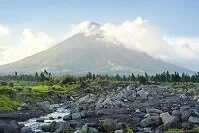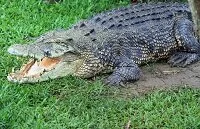Weather

Mayon Volcano
What the Filipinos call their "Cold Season" may be laughable to most foreigners, but their hot and rainy season are definitely as advertised. Hot season runs from about March to May as temperatures are regularly in the 80s-90s°F (30-35°C) and have high humidity, although the mountains may be 10-20°F (6-10°C) cooler. The rainy season (June-November) is also very humid, but it rains more, as temperatures remain fairly consistent with those of the hot season. The Cold Season rarely experiences temperatures lower than 75°F (25° C) except in the mountains when they are again 10-20°F (6-10°C) degrees cooler. During this time humidity remains high so it still feels hot. Manila has an average low of about 70°F (21°C) in the cold season, but with high humidity most people still feel hot.
Wildlife

Saltwater crocodile
The Philippines has a huge wildlife population and variety. Among the mammals, there are water buffaloes, goats, horses, monkeys, anteaters, mongooses, and many smaller mammals like mice and squirrels. The sea life is more diverse as the waters surrounding the island nation have thousands of fish and shellfish. Some of the more common species include the tuna, mackerel, squid, shrimp, lobster, oysters, and crab.
Among the many birds that call the islands home or migrate to and from, are hundreds of species, many of which are water fowls. Among the more common birds are kingfishers, herons, pigeons, peacocks, pheasants, doves, eagles, and quails. There are also numerous reptiles on the islands, including crocodiles, turtles, and snakes. There are also a few amphibians, like frogs. A final group to note is the insect population, which is diverse and populous.